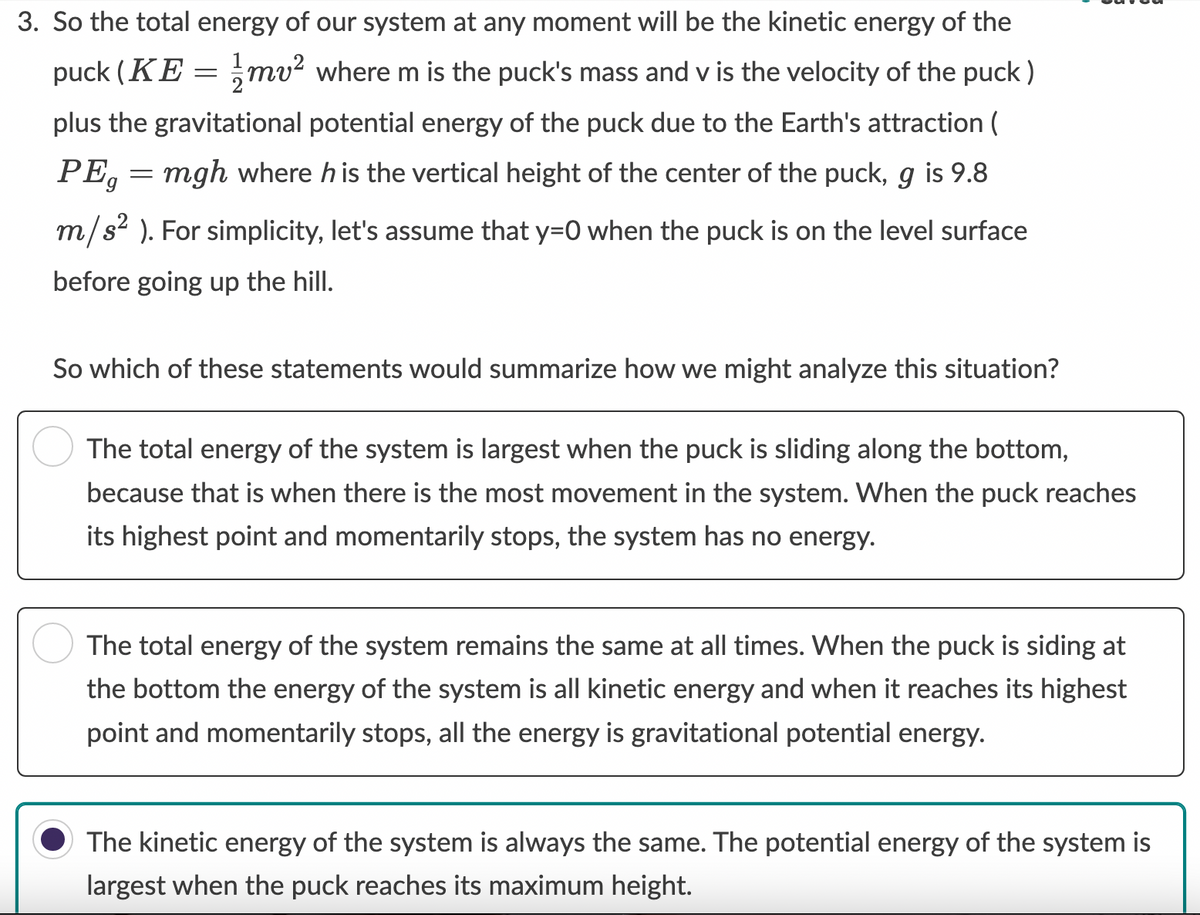So the total energy of our system at any moment will be the kinetic energy of the puck (KE = mv² where m is the puck's mass and v is the velocity of the puck) plus the gravitational potential energy of the puck due to the Earth's attraction ( PE, = mgh where his the vertical height of the center of the puck, g is 9.8 m/s2). For simplicity, let's assume that y=0 when the puck is on the level surface before going up the hill. So which of these statements would summarize how we might analyze this situation? The total energy of the system is largest when the puck is sliding along the bottom, because that is when there is the most movement in the system. When the puck reaches its highest point and momentarily stops, the system has no energy. The total energy of the system remains the same at all times. When the puck is siding at the bottom the energy of the system is all kinetic energy and when it reaches its highest point and momentarily stops, all the energy is gravitational potential energy. The kinetic energy of the system is always the same. The potential energy of the system is largest when the puck reaches its maximum height.
So the total energy of our system at any moment will be the kinetic energy of the puck (KE = mv² where m is the puck's mass and v is the velocity of the puck) plus the gravitational potential energy of the puck due to the Earth's attraction ( PE, = mgh where his the vertical height of the center of the puck, g is 9.8 m/s2). For simplicity, let's assume that y=0 when the puck is on the level surface before going up the hill. So which of these statements would summarize how we might analyze this situation? The total energy of the system is largest when the puck is sliding along the bottom, because that is when there is the most movement in the system. When the puck reaches its highest point and momentarily stops, the system has no energy. The total energy of the system remains the same at all times. When the puck is siding at the bottom the energy of the system is all kinetic energy and when it reaches its highest point and momentarily stops, all the energy is gravitational potential energy. The kinetic energy of the system is always the same. The potential energy of the system is largest when the puck reaches its maximum height.
College Physics
10th Edition
ISBN:9781285737027
Author:Raymond A. Serway, Chris Vuille
Publisher:Raymond A. Serway, Chris Vuille
Chapter6: Momentum And Collisions
Section: Chapter Questions
Problem 10WUE
Related questions
Topic Video
Question

Transcribed Image Text:3. So the total energy of our system at any moment will be the kinetic energy of the
puck (KE = mv² where m is the puck's mass and v is the velocity of the puck)
plus the gravitational potential energy of the puck due to the Earth's attraction (
PE = mgh where his the vertical height of the center of the puck, g is 9.8
m/s²). For simplicity, let's assume that y=0 when the puck is on the level surface
before going up the hill.
So which of these statements would summarize how we might analyze this situation?
The total energy of the system is largest when the puck is sliding along the bottom,
because that is when there is the most movement in the system. When the puck reaches
its highest point and momentarily stops, the system has no energy.
The total energy of the system remains the same at all times. When the puck is siding at
the bottom the energy of the system is all kinetic energy and when it reaches its highest
point and momentarily stops, all the energy is gravitational potential energy.
The kinetic energy of the system is always the same. The potential energy of the system is
largest when the puck reaches its maximum height.
Expert Solution
This question has been solved!
Explore an expertly crafted, step-by-step solution for a thorough understanding of key concepts.
This is a popular solution!
Trending now
This is a popular solution!
Step by step
Solved in 3 steps

Knowledge Booster
Learn more about
Need a deep-dive on the concept behind this application? Look no further. Learn more about this topic, physics and related others by exploring similar questions and additional content below.Recommended textbooks for you

College Physics
Physics
ISBN:
9781285737027
Author:
Raymond A. Serway, Chris Vuille
Publisher:
Cengage Learning

Physics for Scientists and Engineers, Technology …
Physics
ISBN:
9781305116399
Author:
Raymond A. Serway, John W. Jewett
Publisher:
Cengage Learning

College Physics
Physics
ISBN:
9781938168000
Author:
Paul Peter Urone, Roger Hinrichs
Publisher:
OpenStax College

College Physics
Physics
ISBN:
9781285737027
Author:
Raymond A. Serway, Chris Vuille
Publisher:
Cengage Learning

Physics for Scientists and Engineers, Technology …
Physics
ISBN:
9781305116399
Author:
Raymond A. Serway, John W. Jewett
Publisher:
Cengage Learning

College Physics
Physics
ISBN:
9781938168000
Author:
Paul Peter Urone, Roger Hinrichs
Publisher:
OpenStax College
